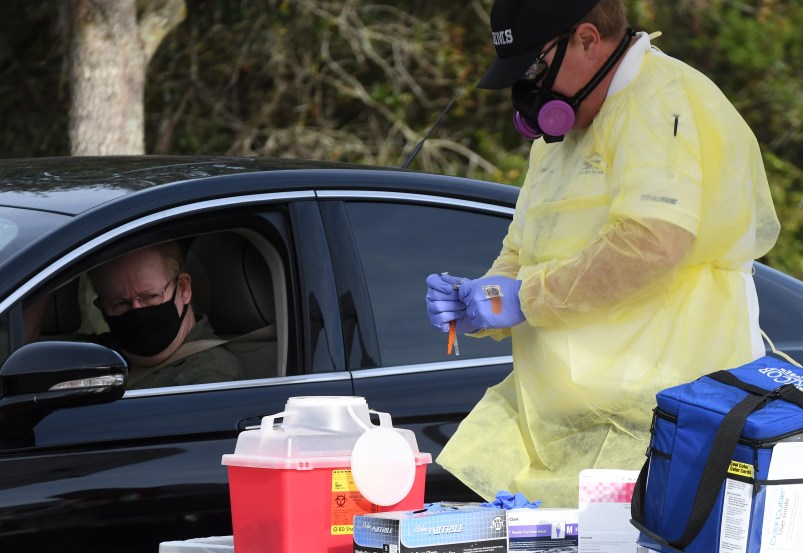The country’s vaccine rollout has hit a snag: pharmaceutical companies can’t make shots fast enough.
As a result the flow of currently approved vaccine, Biden administration officials say, won’t increase significantly until March.
“I think that the supply is probably going to be the most limiting constraint early on, and we’re really hoping that after that first hundred days we will have much more production,” CDC Director Rochelle Walensky said on Sunday.
Those delays, experts told TPM, are due to a series of bottlenecks, for which one solution has been repeatedly floated: The Defense Production Act.
It’s a Korean War-era law that empowers the government to force private companies to manufacture items on command, compelling the company to produce and deliver to the government before other orders that it had previously scheduled.
But while the Biden administration is eyeing the use of the DPA to clear up the bottlenecks, it’s not clear how effective it would be in the world of advanced pharmaceuticals, which rely on a supply chain that’s not only incredibly complex, but international, placing components of it out of reach of U.S. government powers.
Lipid courage
White House Press Secretary Jen Psaki said on Friday that the Biden administration was considering the measure to alleviate one particular bottleneck in vaccine production: a shortage of a fatty substance called lipid nanoparticles.
To understand the bottleneck, it’s important to understand what lipid nanoparticles do and how they’re made.
It’s a little-known but crucial component to the mRNA vaccines — the two shots currently with emergency authorization made by Pfizer and Moderna. Used as a “protective shield” for the active component of the vaccine, the particles allow mRNA to safely deploy in the body.
The nonoparticles are “a protective shield that’s needed temporarily just to keep the mRNA intact until it can get into the body,” Dr. William Schaffner, professor of preventative medicine at Vanderbilt University, told TPM.
“mRna is a very fragile molecule — it disintegrates very, very quickly,” Schaffner said. “So it has to be protected while it’s in the vial and as its delivered into the body through the vaccination process.”
But as crucial as they are, lipid nanoparticles are tricky to produce.
The chemical inputs that go into creating them — fatty acids and triglycerides, among other things — are currently not manufactured at the scale needed to meet demand. At the same time, Dr. Aliasger Salem, a professor of pharmaceuticals and biochemical engineering at the University of Iowa, told TPM, creating the conditions for those chemicals to meld into a protective layer requires specialized equipment and knowledge.
“You had a relatively small population needing these before, and now you’re talking about needing a heck of a lot more,” Salem added.
DPA to come?
There are chemical companies that supply the inputs for the protective coating, but it remains unclear how far they can scale up to meet the level of demand required.
Schaffner, the Vanderbilt doctor, said that the relatively limited supply of chemicals was hindering production.
That’s one place where the Biden administration could use the DPA. Psaki’s statement suggested that the Biden administration may invoke the DPA to alleviate the stress that the lipid issue has placed on the system.
The DPA would allow the government to compel production from companies, which would then trickle down to that firm’s suppliers, David Kaufman, Director for Safety and Security at CNA and a former FEMA official, told TPM.
“The DPA can be used effectively for complex commodities in part because a priority rating can flow down to component parts,” he said. “So you’re not necessarily just placing the rating on a procurement for the finished product. It can flow down to the source materials.”
But that’s complicated by the the international supply chains on which Pfizer and Moderna rely to produce the mRNA vaccines. The DPA only applies domestically, Kaufman said, meaning that foreign companies supplying an American company wouldn’t necessarily have to obey a DPA order from the Biden administration.
The Biden administration’s focus on the DPA to address the lipid shortage isn’t the first time that the problem has arisen in the course of the COVID-19 pandemic.
In December, the Trump administration had a showdown with Pfizer over using the law to spur production of the company’s COVID-19 vaccine.
The drug manufacturer had been warning since September that its vaccine shipments would be slowed absent a DPA order, and had been asking the Trump administration to issue one forcing its suppliers to prioritize Pfizer shipments and result in faster vaccine.
The New York Times reported at the time that lipids, used to make the protective coating, was on the list of supplies for which the firm needed a DPA order.
It remains unclear whether the Trump administration agreed to issue the order.
The law is also under discussion for other uses, like compelling rival drug and supply manufacturers to enter the vaccine supply chain or to order firms to drastically expand their capacity to produce vaccine components.
But it remains unclear how long it would take to increase the amount of raw materials available to make a significant difference in the flow of vaccine. “Production is always going to be guided by the availability of ingredients,” Salem said.



